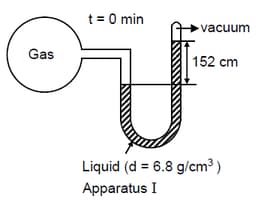HARD
Earn 100
Given a first-order reaction which takes place as follows: Total pressure observed is as follows:


Which is/are correct statement(s)?


(a)Rate of appearance of is equal to
(b)Half life period of reaction is equal to
(c)of the reaction is completed in
(d) of reaction is completed in
100% studentsanswered this correctly
Important Questions on Chemical Kinetics
HARD
The decomposition reaction is started in a closed cylinder under the isothermal isochoric condition at an initial pressure of . After , the pressure inside the cylinder is found to be . If the rate constant of the reaction is , assuming ideal gas behaviour, the value of is(nearest integer)
MEDIUM
The rate constant for the first order reaction is How much time will it take to reduce the concentration of the reactant to value?
MEDIUM
If the rate constant for a first order reaction is , the time required for the completion of of the reaction is given by
MEDIUM
The rate constant of a first order reaction is . How long will of this reactant reduce to ?
EASY
The rate constant for a first order reaction is If initial concentration of the reactant is , what is the half-life of the reaction?
MEDIUM
The plot of v/s for a reaction is a straight-line parallel to -axis. The unit for the rate constant of this reaction is
MEDIUM
During the nuclear explosion, one of the products is with half life of years. If of was absorbed in the bones of a newly born baby in place of how much time, in years, is required to reduce it by if it is not lost metabolically ____________.
HARD
Which of the following plots is(are) correct for the given reaction?
( is the initial concentration of )

EASY
Which among the following reactions can be an example of pseudo first order reaction?
EASY
A first-order reaction has a specific reaction rate How much time will it take for the reactant to reduce to ?
MEDIUM
If of a first order reaction was completed in minutes, of the same reaction would be completed in approximately (in minutes) _____
(Take: )
HARD
For a first order reaction at constant volume and 300 K, the total pressure at the beginning and at time are , respectively. Initially, only A is present with concentration , and is the time required for the partial pressure of A to reach of its initial value. The correct option(s) is (are)
(Assume that all these gases behave as ideal gases)
MEDIUM
A flask contains a mixture of compounds and . Both compounds decompose by first-order kinetics. The half-lives for and are and , respectively. If the concentrations of and are equal initially, the time required for the concentration of A to be four times that of (in s) is :
HARD
The reaction follows first order kinetics. The pressure of a vessel containing only was found to increase from 50 mm Hg to 87.5 mm Hg in 30 min. The pressure exerted by the gases after 60 min. Will be (Assume temperature remains constant) :
MEDIUM
The rate constant for a first order reaction is . The time required to reduce of the reactant to is :
MEDIUM
Under what condition a bimolecular reaction behaves kinetically first order reaction?
MEDIUM
A first order reaction is found to have a rate constant, . Find the half life of the reaction.
HARD
The half-life period of a first-order reaction is . The amount of substance left after one hour will be
EASY
When initial concentration of a reactant is doubled in a reaction, its half-life period is not affected. The order of the reaction is:
MEDIUM
The rate of a first-order reaction is at second and at seconds after initiation of the reaction. The half-life period of the reaction is:

